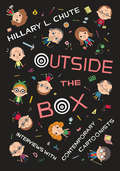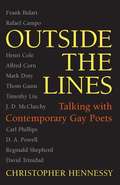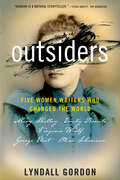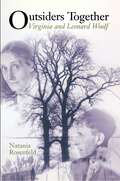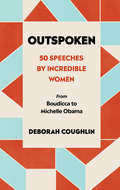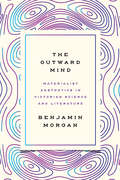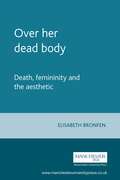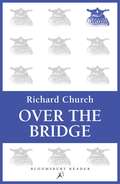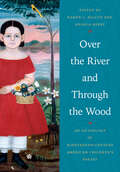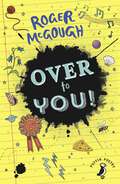- Table View
- List View
Outside the Box: Interviews with Contemporary Cartoonists
by Hillary L. ChuteWe are living in a golden age of cartoon art. Never before has graphic storytelling been so prominent or garnered such respect: critics and readers alike agree that contemporary cartoonists are creating some of the most innovative and exciting work in all the arts. For nearly a decade Hillary L. Chute has been sitting down for extensive interviews with the leading figures in comics, and with Outside the Box she offers fans a chance to share her ringside seat. Chute’s in-depth discussions with twelve of the most prominent and accomplished artists and writers in comics today reveal a creative community that is richly interconnected yet fiercely independent, its members sharing many interests and approaches while working with wildly different styles and themes. Chute’s subjects run the gamut of contemporary comics practice, from underground pioneers like Art Spiegelman and Lynda Barry, to the analytic work of Scott McCloud, the journalism of Joe Sacco, and the extended narratives of Alison Bechdel, Charles Burns, and more. They reflect on their experience and innovations, the influence of peers and mentors, the reception of their art and the growth of critical attention, and the crucial place of print amid the encroachment of the digital age. Beautifully illustrated in full-color, and featuring three never-before-published interviews—including the first published conversation between Art Spiegelman and Chris Ware—Outside the Box will be a landmark volume, a close-up account of the rise of graphic storytelling and a testament to its vibrant creativity.
Outside the Lines: Talking with Contemporary Gay Poets
by Christopher Hennessy"Outside the Lines explores the personal and historical forces that have shaped the work of a dozen gifted poets. The answers given to Hennessy's astute, perfectly tailored questions remind a reader how exciting poetry can be, and how writers create, through language, the world as we have never known it. These adventuresome interviews will stir anyone who cares about the making of art." ---Bernard Cooper, author of Maps to Anywhere Editor Christopher Hennessy gathers interviews with some of the most significant figures in contemporary American poetry. While each poet is gay, these encompassing, craft-centered interviews reflect the diversity of their respective arts and serve as a testament to the impact gay poets have had and will continue to have on contemporary poetics. The book includes twelve frank, intense interviews with some of America's best-known and loved poets, who have not only enjoyed wide critical acclaim but who have had lasting impact on both the gay tradition and the contemporary canon writ large, for example, Frank Bidart, the late Thom Gunn, and J. D. McClatchy. Some of the most honored and respected poets, still in the middle of their careers, are also included, for example, Mark Doty, Carl Phillips, and Reginald Shepherd. Each interview explores the poet's complete work to date, often illuminating the poet's technical evolution and emotional growth, probing shifts in theme, and even investigating links between verse and sexuality. In addition to a selected bibliography of works by established poets, the book also includes a list of works by newer and emerging poets who are well on their way to becoming important voices of the new millennium.
Outsiders: Five Women Writers Who Changed the World
by Lyndall GordonMary Shelley, Emily Bront;«, George Eliot, Olive Schreiner and Virginia Woolf: they all wrote dazzling books that forever changed the way we see history. In Outsiders, award-winning biographer Lyndall Gordon shows how these five novelists shared more than talent. In a time when a woman's reputation was her security, each of these women lost hers. They were unconstrained by convention, writing against the grain of their contemporaries, prophetically imagining a different future. We have long known the individual greatness of each of these writers, but in linking their creativity to their lives as outcasts, Gordon throws new light on the genius they share. All five lost their mothers in childbirth or at a young age. With no female role model present, they learned from books;¢;‚¬;€?and sometimes from an enlightened mentor. Crucially, each had to imagine what a woman could be in order to invent a voice of her own. The passion in their own lives infused their fiction. Writing with passionate intelligence of her own, Gordon reveals that these renegade writers inspired a new breed of women who wished to change a world locked in war, violence, exploitation, and sexual abuse.Gordon's biographies have always shown the indelible connection between life and art: an intuitive, exciting and revealing approach that has been highly praised. In Outsiders, she crafts nuanced portraits of Shelley, Bront;«, Eliot, Schreiner and Woolf, naming each of these writers as prodigy, visionary, 'outlaw,' orator, and explorer, and shows how they came, they saw, and they left us changed. Today, following the tsunami of women's protest at widespread abuse, we do more than read them; we listen and live with their astonishing bravery and eloquence.
Outsiders: Five Women Writers Who Changed the World
by Lyndall GordonMary Shelley, Emily Bront;«, George Eliot, Olive Schreiner and Virginia Woolf: they all wrote dazzling books that forever changed the way we see history. In Outsiders, award-winning biographer Lyndall Gordon shows how these five novelists shared more than talent. In a time when a woman's reputation was her security, each of these women lost hers. They were unconstrained by convention, writing against the grain of their contemporaries, prophetically imagining a different future. We have long known the individual greatness of each of these writers, but in linking their creativity to their lives as outcasts, Gordon throws new light on the genius they share. All five lost their mothers in childbirth or at a young age. With no female role model present, they learned from books;¢;‚¬;€?and sometimes from an enlightened mentor. Crucially, each had to imagine what a woman could be in order to invent a voice of her own. The passion in their own lives infused their fiction. Writing with passionate intelligence of her own, Gordon reveals that these renegade writers inspired a new breed of women who wished to change a world locked in war, violence, exploitation, and sexual abuse.Gordon's biographies have always shown the indelible connection between life and art: an intuitive, exciting and revealing approach that has been highly praised. In Outsiders, she crafts nuanced portraits of Shelley, Bront;«, Eliot, Schreiner and Woolf, naming each of these writers as prodigy, visionary, 'outlaw,' orator, and explorer, and shows how they came, they saw, and they left us changed. Today, following the tsunami of women's protest at widespread abuse, we do more than read them; we listen and live with their astonishing bravery and eloquence.
Outsiders Together: Virginia and Leonard Woolf
by Natania RosenfeldThe marriage of Virginia and Leonard Woolf is best understood as a dialogue of two outsiders about ideas of social and political belonging and exclusion. These ideas infused the written work of both partners and carried over into literary modernism itself, in part through the influence of the Woolfs' groundbreaking publishing company, the Hogarth Press. In this book, the first to focus on Virginia Woolf's writings in conjunction with those of her husband, Natania Rosenfeld illuminates Leonard's sense of ambivalent social identity and its affinities to Virginia's complex ideas of subjectivity. At the time of the Woolfs' marriage, Leonard was a penniless ex-colonial administrator, a fervent anti-imperialist, a committed socialist, a budding novelist, and an assimilated Jew who vacillated between fierce pride in his ethnicity and repudiation of it. Virginia was an "intellectual aristocrat," socially privileged by her class and family background but hobbled through gender. Leonard helped Virginia elucidate her own prejudices and elitism, and his political engagements intensified her identification with outsiders in British society. Rosenfeld discovers an aesthetic of intersubjectivity constantly at work in Virginia Woolf's prose, links this aesthetic to the intermeshed literary lives of the Woolfs, and connects both these sites of dialogue to the larger sociopolitical debates--about imperialism, capitalism, women, sexuality, international relations, and, finally, fascism--of their historical place and time.
Outsiders Together: Virginia and Leonard Woolf
by Natania RosenfeldThe marriage of Virginia and Leonard Woolf is best understood as a dialogue of two outsiders about ideas of social and political belonging and exclusion. These ideas infused the written work of both partners and carried over into literary modernism itself, in part through the influence of the Woolfs' groundbreaking publishing company, the Hogarth Press. In this book, the first to focus on Virginia Woolf's writings in conjunction with those of her husband, Natania Rosenfeld illuminates Leonard's sense of ambivalent social identity and its affinities to Virginia's complex ideas of subjectivity. At the time of the Woolfs' marriage, Leonard was a penniless ex-colonial administrator, a fervent anti-imperialist, a committed socialist, a budding novelist, and an assimilated Jew who vacillated between fierce pride in his ethnicity and repudiation of it. Virginia was an "intellectual aristocrat," socially privileged by her class and family background but hobbled through gender. Leonard helped Virginia elucidate her own prejudices and elitism, and his political engagements intensified her identification with outsiders in British society. Rosenfeld discovers an aesthetic of intersubjectivity constantly at work in Virginia Woolf's prose, links this aesthetic to the intermeshed literary lives of the Woolfs, and connects both these sites of dialogue to the larger sociopolitical debates--about imperialism, capitalism, women, sexuality, international relations, and, finally, fascism--of their historical place and time.
Outspoken: 50 Speeches by Incredible Women from Boudicca to Michelle Obama
by Deborah CoughlinHistory didn’t listen to women, but that never stopped them from speaking out …A lot of history is made up of speeches. Speeches about big ideas, celebratory speeches, rousing speeches to inspire soldiers to fight to the death, comic speeches to help us see the funny side to life. From Jesus to Winston Churchill to Martin Luther King Jr. and even Donald Trump, we’ve been raised with the words of important men ringing in our ears …But where are all the women? Unless you’re the type of person who loves researching suffrage speeches, you are unlikely to know many soundbites from women throughout history. Outspoken: 50 Speeches by Incredible Women is going to change that. From Joan of Arc and Virginia Woolf, to Oprah Winfrey and Greta Thunberg, this is a celebration of outstanding and outspoken women everywhere.
The Outward Mind: Materialist Aesthetics in Victorian Science and Literature
by Benjamin MorganThough underexplored in contemporary scholarship, the Victorian attempts to turn aesthetics into a science remain one of the most fascinating aspects of that era. In The Outward Mind, Benjamin Morgan approaches this period of innovation as an important origin point for current attempts to understand art or beauty using the tools of the sciences. Moving chronologically from natural theology in the early nineteenth century to laboratory psychology in the early twentieth, Morgan draws on little-known archives of Victorian intellectuals such as William Morris, Walter Pater, John Ruskin, and others to argue that scientific studies of mind and emotion transformed the way writers and artists understood the experience of beauty and effectively redescribed aesthetic judgment as a biological adaptation. Looking beyond the Victorian period to humanistic critical theory today, he also shows how the historical relationship between science and aesthetics could be a vital resource for rethinking key concepts in contemporary literary and cultural criticism, such as materialism, empathy, practice, and form. At a moment when the tumultuous relationship between the sciences and the humanities is the subject of ongoing debate, Morgan argues for the importance of understanding the arts and sciences as incontrovertibly intertwined.
The Outward Mind: Materialist Aesthetics in Victorian Science and Literature
by Benjamin MorganThough underexplored in contemporary scholarship, the Victorian attempts to turn aesthetics into a science remain one of the most fascinating aspects of that era. In The Outward Mind, Benjamin Morgan approaches this period of innovation as an important origin point for current attempts to understand art or beauty using the tools of the sciences. Moving chronologically from natural theology in the early nineteenth century to laboratory psychology in the early twentieth, Morgan draws on little-known archives of Victorian intellectuals such as William Morris, Walter Pater, John Ruskin, and others to argue that scientific studies of mind and emotion transformed the way writers and artists understood the experience of beauty and effectively redescribed aesthetic judgment as a biological adaptation. Looking beyond the Victorian period to humanistic critical theory today, he also shows how the historical relationship between science and aesthetics could be a vital resource for rethinking key concepts in contemporary literary and cultural criticism, such as materialism, empathy, practice, and form. At a moment when the tumultuous relationship between the sciences and the humanities is the subject of ongoing debate, Morgan argues for the importance of understanding the arts and sciences as incontrovertibly intertwined.
The Outward Mind: Materialist Aesthetics in Victorian Science and Literature
by Benjamin MorganThough underexplored in contemporary scholarship, the Victorian attempts to turn aesthetics into a science remain one of the most fascinating aspects of that era. In The Outward Mind, Benjamin Morgan approaches this period of innovation as an important origin point for current attempts to understand art or beauty using the tools of the sciences. Moving chronologically from natural theology in the early nineteenth century to laboratory psychology in the early twentieth, Morgan draws on little-known archives of Victorian intellectuals such as William Morris, Walter Pater, John Ruskin, and others to argue that scientific studies of mind and emotion transformed the way writers and artists understood the experience of beauty and effectively redescribed aesthetic judgment as a biological adaptation. Looking beyond the Victorian period to humanistic critical theory today, he also shows how the historical relationship between science and aesthetics could be a vital resource for rethinking key concepts in contemporary literary and cultural criticism, such as materialism, empathy, practice, and form. At a moment when the tumultuous relationship between the sciences and the humanities is the subject of ongoing debate, Morgan argues for the importance of understanding the arts and sciences as incontrovertibly intertwined.
The Outward Mind: Materialist Aesthetics in Victorian Science and Literature
by Benjamin MorganThough underexplored in contemporary scholarship, the Victorian attempts to turn aesthetics into a science remain one of the most fascinating aspects of that era. In The Outward Mind, Benjamin Morgan approaches this period of innovation as an important origin point for current attempts to understand art or beauty using the tools of the sciences. Moving chronologically from natural theology in the early nineteenth century to laboratory psychology in the early twentieth, Morgan draws on little-known archives of Victorian intellectuals such as William Morris, Walter Pater, John Ruskin, and others to argue that scientific studies of mind and emotion transformed the way writers and artists understood the experience of beauty and effectively redescribed aesthetic judgment as a biological adaptation. Looking beyond the Victorian period to humanistic critical theory today, he also shows how the historical relationship between science and aesthetics could be a vital resource for rethinking key concepts in contemporary literary and cultural criticism, such as materialism, empathy, practice, and form. At a moment when the tumultuous relationship between the sciences and the humanities is the subject of ongoing debate, Morgan argues for the importance of understanding the arts and sciences as incontrovertibly intertwined.
The Outward Mind: Materialist Aesthetics in Victorian Science and Literature
by Benjamin MorganThough underexplored in contemporary scholarship, the Victorian attempts to turn aesthetics into a science remain one of the most fascinating aspects of that era. In The Outward Mind, Benjamin Morgan approaches this period of innovation as an important origin point for current attempts to understand art or beauty using the tools of the sciences. Moving chronologically from natural theology in the early nineteenth century to laboratory psychology in the early twentieth, Morgan draws on little-known archives of Victorian intellectuals such as William Morris, Walter Pater, John Ruskin, and others to argue that scientific studies of mind and emotion transformed the way writers and artists understood the experience of beauty and effectively redescribed aesthetic judgment as a biological adaptation. Looking beyond the Victorian period to humanistic critical theory today, he also shows how the historical relationship between science and aesthetics could be a vital resource for rethinking key concepts in contemporary literary and cultural criticism, such as materialism, empathy, practice, and form. At a moment when the tumultuous relationship between the sciences and the humanities is the subject of ongoing debate, Morgan argues for the importance of understanding the arts and sciences as incontrovertibly intertwined.
The Outward Mind: Materialist Aesthetics in Victorian Science and Literature
by Benjamin MorganThough underexplored in contemporary scholarship, the Victorian attempts to turn aesthetics into a science remain one of the most fascinating aspects of that era. In The Outward Mind, Benjamin Morgan approaches this period of innovation as an important origin point for current attempts to understand art or beauty using the tools of the sciences. Moving chronologically from natural theology in the early nineteenth century to laboratory psychology in the early twentieth, Morgan draws on little-known archives of Victorian intellectuals such as William Morris, Walter Pater, John Ruskin, and others to argue that scientific studies of mind and emotion transformed the way writers and artists understood the experience of beauty and effectively redescribed aesthetic judgment as a biological adaptation. Looking beyond the Victorian period to humanistic critical theory today, he also shows how the historical relationship between science and aesthetics could be a vital resource for rethinking key concepts in contemporary literary and cultural criticism, such as materialism, empathy, practice, and form. At a moment when the tumultuous relationship between the sciences and the humanities is the subject of ongoing debate, Morgan argues for the importance of understanding the arts and sciences as incontrovertibly intertwined.
Over her dead body: Death, femininity and the aesthetic
by Elisabeth BronfenThe argument that this book presents is that narrative and visual representations of death can be read as symptoms of our culture and because the feminine body is culturally constructed as the superlative site of "other" and "not me", culture uses art to dream the deaths of beautiful women.
Over The Moon, Book C: Stories 7 to 9 (TC21103) (PDF)
by Jenefer RobertsThe new Over the Moon reading scheme follows on from the Moon Cats scheme and introduces the remaining letters one at a time via a set of eight books containing 24 humorous and interactive stories. The books show the story text in large print on the left-hand page with the key words in bold. The right-hand page has the bold key words written in Moon.
Over The Moon, Book D: Stories 10 to 12 (TC21104) (PDF)
by Jenefer RobertsThe new Over the Moon reading scheme follows on from the Moon Cats scheme and introduces the remaining letters one at a time via a set of eight books containing 24 humorous and interactive stories. The books show the story text in large print on the left-hand page with the key words in bold. The right-hand page has the bold key words written in Moon.
Over The Moon, Book E: Stories 13 to 15 (TC21105) (PDF)
by Jenefer RobertsThe new Over the Moon reading scheme follows on from the Moon Cats scheme and introduces the remaining letters one at a time via a set of eight books containing 24 humorous and interactive stories. The books show the story text in large print on the left-hand page with the key words in bold. The right-hand page has the bold key words written in Moon.
Over The Moon, Book F: Stories 16 to 18 (TC21106) (PDF)
by Jenefer RobertsThe new Over the Moon reading scheme follows on from the Moon Cats scheme and introduces the remaining letters one at a time via a set of eight books containing 24 humorous and interactive stories. The books show the story text in large print on the left-hand page with the key words in bold. The right-hand page has the bold key words written in Moon.
Over The Moon, Book G: Stories 19 to 21 (TC21107) (PDF)
by Jenefer RobertsThe new Over the Moon reading scheme follows on from the Moon Cats scheme and introduces the remaining letters one at a time via a set of eight books containing 24 humorous and interactive stories. The books show the story text in large print on the left-hand page with the key words in bold. The right-hand page has the bold key words written in Moon.
Over The Moon, Book H: Stories 22 to 24 (TC21108) (PDF)
by Jenefer RobertsThe new Over the Moon reading scheme follows on from the Moon Cats scheme and introduces the remaining letters one at a time via a set of eight books containing 24 humorous and interactive stories. The books show the story text in large print on the left-hand page with the key words in bold. The right-hand page has the bold key words written in Moon.
Over the Bridge: An Essay In Autobiography
by Richard ChurchOver the Bridge, the first volume of Richard Church's personal essays, originally published in 1955, takes the reader through the poet's Edwardian childhood adventures. With his detailed descriptions and insightful observations Church paints an idyllic image of his early years passed in the safety of the close-knit lower middle-class home where his loving, hard working parents did all they could to protect their sons from the harsh reality of Britain at the end of the Victorian era. He ponders with humour the disappointments of his first school endeavours; his academic failure made him feel an outcast until it was discovered that not a poor intellectual capacity but rather the child's poor eyesight was to blame for his lack of concentration and understanding of his school subjects. And finally Church takes us through his teenage years, which began happily with a promise of undisturbed literary and artistic pursuits at Camberwell Art School but were soon tainted with worry over the diminishing health of their beloved mother – the pillar of the Church family.Over the Bridge is not only a touching portrait of Church's childhood self but also an intriguing and detailed picture of the social and economic realities of the Edwardian era. In 1955 Over the Bridge was awarded the Sunday Times Prize for Literature.
Over the Moon, Teachers Notes (TC21112) (PDF)
by Jenefer RobertsThe new Over the Moon reading scheme follows on from the Moon Cats scheme and introduces the remaining letters one at a time via a set of eight books containing 24 humorous and interactive stories. The books show the story text in large print on the left-hand page with the key words in bold. The right-hand page has the bold key words written in Moon.
Over the River and Through the Wood: An Anthology of Nineteenth-Century American Children's Poetry
by Karen L. Kilcup Angela SorbyOver the River and Through the Wood is the first and only collection of its kind, offering readers an unequaled view of the quality and diversity of nineteenth-century American children's poetry. Most American poets wrote for children—from famous names such as Ralph Waldo Emerson to less familiar figures like Christina Moody, an African American author who published her first book at sixteen. In its excellence, relevance, and abundance, much of this work rivals or surpasses poetry written for adults, yet it has languished—inaccessible and unread—in old periodicals, gift books, and primers. This groundbreaking anthology remedies that loss, presenting material that is both critical to the tradition of American poetry and also a delight to read.Complemented by period illustrations, this definitive collection includes work by poets from all geographical regions, as well as rarely seen poems by immigrant and ethnic writers and by children themselves. Karen L. Kilcup and Angela Sorby have combed the archives to present an extensive selection of rediscoveries along with traditional favorites. By turns playful, contemplative, humorous, and subversive, these poems appeal to modern sensibilities while giving scholars a revised picture of the nineteenth-century literary landscape.
Over the River and Through the Wood: An Anthology of Nineteenth-Century American Children's Poetry
by Angela Sorby Karen L. KilcupOver the River and Through the Wood is the first and only collection of its kind, offering readers an unequaled view of the quality and diversity of nineteenth-century American children's poetry. Most American poets wrote for children—from famous names such as Ralph Waldo Emerson to less familiar figures like Christina Moody, an African American author who published her first book at sixteen. In its excellence, relevance, and abundance, much of this work rivals or surpasses poetry written for adults, yet it has languished—inaccessible and unread—in old periodicals, gift books, and primers. This groundbreaking anthology remedies that loss, presenting material that is both critical to the tradition of American poetry and also a delight to read.Complemented by period illustrations, this definitive collection includes work by poets from all geographical regions, as well as rarely seen poems by immigrant and ethnic writers and by children themselves. Karen L. Kilcup and Angela Sorby have combed the archives to present an extensive selection of rediscoveries along with traditional favorites. By turns playful, contemplative, humorous, and subversive, these poems appeal to modern sensibilities while giving scholars a revised picture of the nineteenth-century literary landscape.
Over to You!
by Roger McGoughA brand new collection for children from beloved poet, writer and broadcaster - Roger McGoughJust when you are ready to write your first poem, along come the words and cause mayhem! 'Poems can be like that sometimes,' says Roger McGough.Here Roger's witty poems take you from school and home to places far and wide, and back again just in time to finish the poem you first started.
